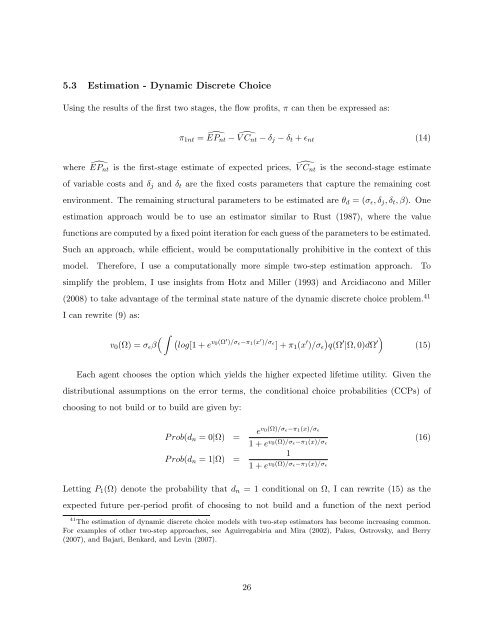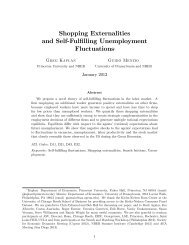A Dynamic Model of Housing Supply
A Dynamic Model of Housing Supply
A Dynamic Model of Housing Supply
Create successful ePaper yourself
Turn your PDF publications into a flip-book with our unique Google optimized e-Paper software.
5.3 Estimation - <strong>Dynamic</strong> Discrete ChoiceUsing the results <strong>of</strong> the first two stages, the flow pr<strong>of</strong>its, π can then be expressed as:π 1nt = ÊP nt − ̂V C nt − δ j − δ t + ɛ nt (14)where ÊP nt is the first-stage estimate <strong>of</strong> expected prices, ̂V C nt is the second-stage estimate<strong>of</strong> variable costs and δ j and δ t are the fixed costs parameters that capture the remaining costenvironment. The remaining structural parameters to be estimated are θ d = (σ ɛ , δ j , δ t , β). Oneestimation approach would be to use an estimator similar to Rust (1987), where the valuefunctions are computed by a fixed point iteration for each guess <strong>of</strong> the parameters to be estimated.Such an approach, while efficient, would be computationally prohibitive in the context <strong>of</strong> thismodel. Therefore, I use a computationally more simple two-step estimation approach. Tosimplify the problem, I use insights from Hotz and Miller (1993) and Arcidiacono and Miller(2008) to take advantage <strong>of</strong> the terminal state nature <strong>of</strong> the dynamic discrete choice problem. 41I can rewrite (9) as:v 0 (Ω) = σ ɛ β( ∫ (log[1 + ev 0 (Ω ′ )/σ ɛ−π 1 (x ′ )/σ ɛ] + π 1 (x ′ )/σ ɛ)q(Ω ′ |Ω, 0)dΩ ′) (15)Each agent chooses the option which yields the higher expected lifetime utility. Given thedistributional assumptions on the error terms, the conditional choice probabilities (CCPs) <strong>of</strong>choosing to not build or to build are given by:P rob(d n = 0|Ω) =P rob(d n = 1|Ω) =e v 0(Ω)/σ ɛ−π 1 (x)/σ ɛ1 + e v (16)0(Ω)/σ ɛ−π 1 (x)/σ ɛ11 + e v 0(Ω)/σ ɛ−π 1 (x)/σ ɛLetting P 1 (Ω) denote the probability that d n = 1 conditional on Ω, I can rewrite (15) as theexpected future per-period pr<strong>of</strong>it <strong>of</strong> choosing to not build and a function <strong>of</strong> the next period41 The estimation <strong>of</strong> dynamic discrete choice models with two-step estimators has become increasing common.For examples <strong>of</strong> other two-step approaches, see Aguirregabiria and Mira (2002), Pakes, Ostrovsky, and Berry(2007), and Bajari, Benkard, and Levin (2007).26
















